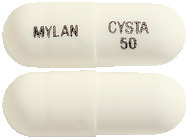1. Why am I taking CYSTAGON?
CYSTAGON contains the active ingredient mercaptamine (cysteamine) bitartrate. CYSTAGON is used to manage nephropathic cystinosis, in children and adults.
For more information, see Section 1. Why am I taking CYSTAGON? in the full CMI.
2. What should I know before I take CYSTAGON?
Do not take if you have ever had an allergic reaction to mercaptamine, penicillamine, or any of the ingredients listed at the end of the CMI.
Talk to your doctor if you have any other medical conditions, take any other medicines, or are pregnant or plan to become pregnant or are breastfeeding.
For more information, see Section 2. What should I know before I take CYSTAGON? in the full CMI.
3. What if I am taking other medicines?
Some medicines may interfere with CYSTAGON and affect how it works.
A list of these medicines is in Section 3. What if I am taking other medicines? in the full CMI.
4. How do I take CYSTAGON?
- The dose of CYSTAGON is based on your weight.
More instructions can be found in Section 4. How do I take CYSTAGON? in the full CMI.
5. What should I know while taking CYSTAGON?
| Things you or your child should do |
|
| Things you should not do |
|
| Driving or using machines |
|
| Looking after your medicine |
|
For more information, see Section 5. What should I know while taking CYSTAGON? in the full CMI.
6. Are there any side effects?
Less serious side effects include nausea, vomiting, loss of appetite, diarrhoea, drowsiness, rash, unpleasant breath odour, fever or feel tired or fatigued.
Serious side effects include stomach pain, loss of appetite, throwing up blood, seizures, depression, excessive sleepiness, low white blood cell count, abnormal liver function headache, dizziness, double vision, blurry vision, loss of vision, pain behind the eye or pain with eye movement, skin lesions, bone lesions or joint problems.
Please note this is not a complete list of possible side effects.
For more information, including what to do if you have any side effects, see Section 6. Are there any side effects? in the full CMI.

